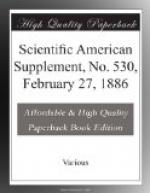In professional circles, as also among the public, the value of this invention cannot possibly be underestimated; an invention with which a new epoch in photography may begin, and by which the handsomest results, particularly in reproductions of oil paintings, can be attained. But in portraiture, as well as in landscape photography, recourse must also be had to orthochromatic plates to obtain effective pictures, particularly as plates can now be produced in which the relative sensitiveness closely resembles that of the ordinary emulsion plate. Although a good deal has been written about this subject, none of these sometimes excellent treatises contains a complete and generally comprehensive formula for the production of color-sensitive plates, and this circumstance causes me to publish my own experiences.
The following coloring matters are particularly recommended in the several publications as preferable:
Eosine yellow and eosine blue shade, iodine cyanin, erythrosine, methyl violet, aniline violet, iodine green, azalein, Hoffmann’s violet, acid green, methyl green, rose bengal, pyrosine, chlorophyl, saffrosine, coralline, saffranine, etc.
Particularly important is the correct concentration. The most excellent color matters make the plates oftentimes quite useless by an incorrect proportion of concentration. If this should be too strong, the total sensitiveness will sink (decrease); but when too weak, the color sensitiveness is much reduced.
This fault, particularly, cannot be corrected during washing, but I have mentioned, at the end, how such overcolored emulsion can be made of use before wetting (flowing).
By the addition of some coloring matter to the emulsion, the light sensitiveness of the film toward some individual colored rays is increased, but the sensitiveness for the stronger refractive rays is, as a rule, generally reduced. The result is a loss of the total sensitiveness for white light. Color-sensitive plates are therefore less sensitive to light than ordinary plates of the same origin.
The action of the coloring matter depends also very essentially upon the emulsion. If the emulsion contains iodide of silver, it has a greater sensitiveness for light blue and blue-green light. At all events, the iodide combination must not amount to more than one or two per cent., a small quantity of iodine acting much better upon the total sensitiveness of the plates than can be obtained by pure bromide of silver emulsion.
Methyl violet, rose bengal, and azalein act perceptibly in 1/10000 per cent. upon yellow sensitiveness. Eosine and its varieties, eosine yellow shade, or eosine J, pyrosine J, erythrosine yellowish, may all be noted as very good sensitizers for green, yellow-green, and eventually for yellow. The bluish shades of eosine colors, on the contrary, have an absorption band further in the yellow. This is also the case with the blue shade eosine (eosine B) and the most bluish of all eosines, the bengal rosa. Of both eosines, yellow shade and blue shade, the latter gives a little more intensity.




